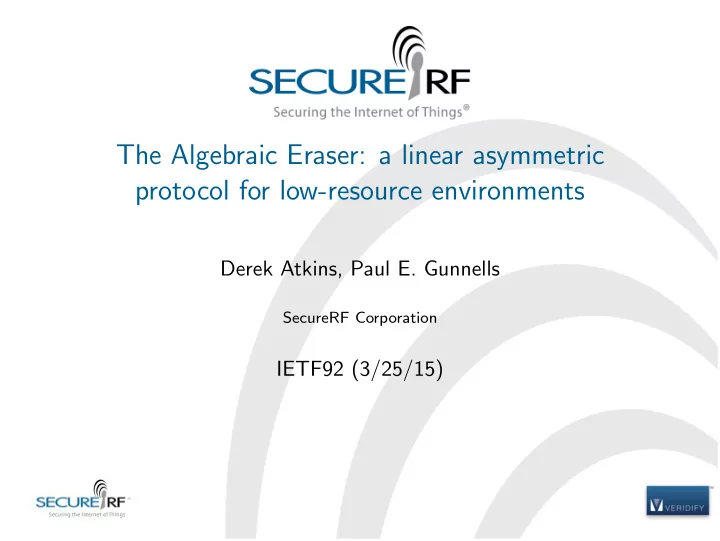

The Algebraic Eraser: a linear asymmetric protocol for low-resource environments Derek Atkins, Paul E. Gunnells SecureRF Corporation IETF92 (3/25/15)
Algebraic Eraser ◮ I. Anshel, M. Anshel, D. Goldfeld, and S. Lemieux, Key agreement, the Algebraic Eraser TM , and lightweight cryptography , Algebraic methods in cryptography, Contemp. Math., vol. 418, Amer. Math. Soc., Providence, RI, 2006, pp. 1–34. ◮ Asymmetric key agreement protocol ◮ Designed for low-cost platforms with constrained computational resources ◮ RFID ◮ Bluetooth ◮ NFC ◮ “Internet of Things” ◮ Complexity scales linearly with desired security level, unlike RSA, ECC.
AE Performance vs ECC 2 128 Security level (AES–128) ECC 283 AE B 16 , F 256 Gain Cycles Gates Wtd. Perf. Cycles Gates Wtd. Perf. 164,823 29,458 4,855,355,934 71.7x 85,367 77,858 6,646,503,866 3,352 20,206 67,730,512 98.1x 70,469 195,382 13,768,374,158 203.3x Wtd. Perf. is Weighted Performance (clock cycles × gate count) and represents time and power usage. Gate counts are for 65nm CMOS. ECC data taken from A Flexible Soft IP Core for Standard Implementations of Elliptic Curve Cryptography in Hardware , B. Ferreira and N. Calazans, 2013 IEEE 20th International Conference on Electronics, Circuits, and Systems (ICECS), 12/2013.
Overview of AE ◮ The AE key exchange is a nonabelian Diffie–Hellman exchange. ◮ The underlying algebraic structure is not ( Z / N Z ) × or E ( F q ), but rather ◮ M n ( F q ) ( n × n matrices over F q ), ◮ B n (the braid group on n strands). ◮ Private keys: a pair R = ( m , µ ) of a matrix and braid. ◮ Public keys: a pair P = ( M , σ ) of a matrix and a permutation in S n . ◮ Each user also knows a fixed ordered list of elements of F q ( T-values ). ◮ The shared secret: same kind of pair as the public key.
Overview of AE ◮ The security level depends on n , q and the lengths of the private braids (and scales linearly with the lengths of the braids). ◮ The (maximum) security level for AE is n · lg q , not (lg q ) / 2 as in ECC. In particular one can use moderately sized finite fields, not multiprecision finite fields. ◮ The hard computational problem underlying AE takes place in the braid group B n , and is known as the Simultaneous conjugacy separation search problem . This is not the same computational problem underlying earlier braid group schemes, and AE is not “Braid Group Cryptography.”
Braids A braid on n strands is a collection of n entangled strings. We can represent a braid by a left-right crossing sequence of signed nonzero integers i 1 i 2 · · · i k , (“Artin generators”) each of which lies between − n and n . ◮ A positive integer i means “cross the i th strand under the ( i + 1)st strand.” ◮ A negative integer − i means “cross the i th strand over the ( i + 1)st strand.” 1 2 3 1 2 1 3 − 3 − 2 − 2 1 − 3 − 1
E -multiplication E -multiplication is an action of B n on M n ( F q ) ◮ Each Artin generator determines an n × n sparse matrix, a colored Burau matrix . ◮ This matrix depends on the T -values (the fixed set of elements in F q ), but the correspondence between generators and matrices changes as one moves down the braid in the private key. ◮ This nontrivial permuting of the T -values is the “eraser” part of the construction. Effectively it masks the map between braids and matrices. ◮ E -multiplication is how the public keys are produced from the private data: P A = m A ⋆ µ A , P B = m B ⋆ µ B ( A = Alice, B = Bob).
Shared secret computation ◮ Bob and Alice take each others public keys P A = ( M A , σ A ) , P B = ( M B , σ B ), and multiply their private matrices m A , m B against them. ◮ Then they E -multiply the result by their braids µ A , µ B : S A = P B m A ⋆ µ A , S B = P A m B ⋆ µ B . ◮ We have S A = S B . Many details have of course been elided, for example how one chooses the matrices and braids.
Thank You! SecureRF Corporation 100 Beard Sawmill Rd, Suite 350 Shelton, CT 06484 Derek Atkins (datkins@securerf.com) Paul Gunnells (pgunnells@securerf.com)
Recommend
More recommend